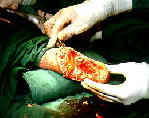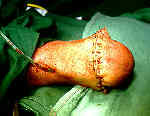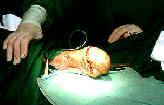- Discussion:
- includes ankle disarticulation, removal of malleoli, & anchoring heel pad to the wt bearing surface) allows execellent gait with a cosmetic
prosthesis;
- symes amputations will not heal w/o palpable posterior artery pulse;
- surgery may be performed in 2 stages;
- most common indication for this is infection;
- ankle is disarticulated in the first stage and the amputation is revised approximately 6 weeks later during the second stage;
- components of the 2nd stage include resection of the malleoli flush w/ joint surface, fixation of the fat pad to residual bone, and revision of
redundant skin;
- this amputation allows for intermittent wt bearing; however, skin break down may occur if a prosthesis is used on a regular basis;
- majority of patients w/ Syme's amputation will require prothesis designed to relieve end weight bearing;
- Case Example: by Jan Van Der Bauwhede MD




© 1993-1997 Jan Van Der Bauwhede MD
Leg-length inequality in children treated by Syme's amputation.
The Syme amputation in children.
Congenital longitudinal deficiency of the fibula: follow-up of treatment by Syme amputation.
The Syme amputation in patients with congenital pseudarthrosis of the tibia.
Syme's amputation in adults: a long-term review.
Syme amputation in children: indications, results, and long-term follow-up.
Partial foot amputations in children. A comparison of the several types with the Syme amputation.
Syme amputation. An evaluation of the physical and psychological function in young patients.
Syme Ankle Disarticulation in Patients with Diabetes
Partial foot amputations in children. A comparison of the several types with the Syme amputation.
The Syme amputation: success in elderly diabetic patients with palpable ankle pulses.

